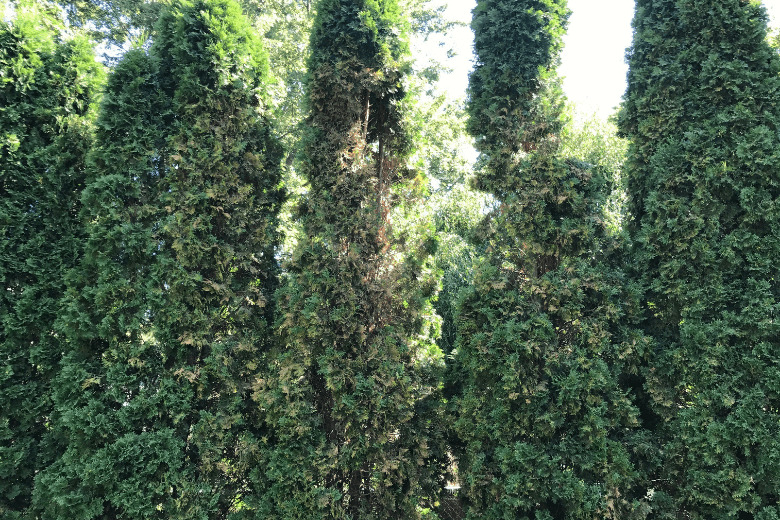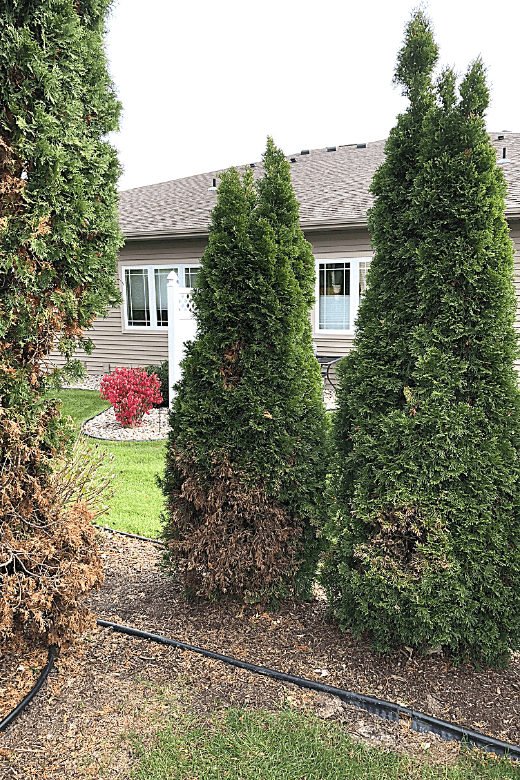One of the main reasons you likely planted arborvitae on your property is because they’re evergreen. A splash of year-round greenery adds a pop of color to what can be an otherwise drab landscape in winter. Although arborvitae is fairly easy to grow, they do sometimes suffer from stress-related browning. Often when we’re consulting with a client on a property we’re asked, “Why is my arborvitae turning brown?“
In this article, we’ll delve into what causes browning, how to prevent it, and what to do about it if you do notice it on your arborvitae. In worst case scenarios, the plant may need to be removed by a professional and replaced. More on that below!

What causes browning on Arborvitae?
Arborvitae can be a wonderful addition to your landscape because they’re so adaptable. They can grow in full sun or partial shade and have the ability to thrive in a variety of soil conditions from heavy clay to light sand. But, like all plants, they are susceptible to unfavorable environmental conditions that can cause stress and even death.
Here are some of the reasons why your arborvitae might be turning brown.
Too Little Water
In most soils and conditions a good rule of thumb to follow is that most established plants need about 1 inch of water per week. If your area isn’t getting regular rainfall and you’re not offering your arborvitae supplemental water it will begin to become stressed out, often showing signs of browning.
Drying Winds
Strong winds, both in winter and summer, can lead to water loss in trees and shrubs. In winter if the ground is frozen the plant’s roots won’t be able to replenish the lost moisture. In summer, restoring lost moisture can also be an issue when the temperatures are high and rainfall is scarce.
High Temperatures
Transpiration is the evaporation of water from plant leaves. Higher temperatures cause the plant cells which control the openings (stoma) where water is released to the atmosphere to open, whereas colder temperatures cause the openings to close. Therefore, water loss is higher in the summer, and if that water isn’t replaced your arborvitae may start to become drought-stressed.
Immature Root System
Newly planted trees and shrubs don’t have fully developed root systems, which inhibit their ability to efficiently take up water to keep the leaves hydrated. If your plants were planted recently, this could be one of the causes of arborvitae turning brown.
Injury to the Roots
The roots of trees and shrubs absorb and transport water and minerals from the soil to the rest of the tree. If the roots of your arborvitae are damaged for any reason – digging, roto-tilling, animals – then the amount of water the roots will be able to deliver to the rest of the plant will be compromised.
Damage to the Trunk
Wounds on a trunk that infiltrate the bark will damage the cambium layer, a thin layer of vascular tissue, which moves water and nutrients throughout the plant. Like many of these other causes of browning, this one is also related to a lack of adequate water. If the cambium is damaged in a large portion of the trunk the arborvitae will have trouble delivering water to the leaves. Luckily, if less than 25% of the bark around the trunk has been damaged, the tree will probably recover.
Winter Burn
Trees and shrubs grown in open, unprotected locations and exposed to severe winter conditions are more likely to suffer winter burn. Foliage starts to brown at the tips of branches and progresses inward toward the center of the plant. Foliage facing south, southwest, or west is most often affected because on sunny winter days the parts facing the sun often begin to transpire (lose water through the leaves). Because the ground is frozen, plant roots cannot take up water and replace the water that has been lost from the leaves or needles. As a result, it dries and browns.

How to Prevent Browning
One of the difficult parts of growing arborvitae is that sometimes they don’t show they’re stressed out until very late in the game. And sometimes they can go from browning leaves to completely dead before you even have a chance to address the issues.
But, now that you’re familiar with the causes of your arborvitae turning brown it’s time to learn some techniques you can use to prevent it.
Plant in a Sheltered Location
If you’re considering planting arborvitae on your property the best choice for a location is one that’s protected from harsh winds throughout the year and direct sun in the winter. Consider planting arborvitae on the north or east side of a building or other protected area like a courtyard.
Plant in Spring
Planting trees and shrubs in early spring will give them plenty of time to establish a robust root system during the season which will help them deliver much-needed water to leaves to prevent browning. If planting arborvitae later in the season try to wait until early fall when the summer heat has passed, but don’t wait until right before winter because the roots won’t have any time to establish.
Read more about how to set up newly planted trees for success and avoid tree transplant shock.
Mulch the Root Zone
Next to watering, mulching is arguably the best practice for keeping newly planted or even older, established trees and shrubs healthy long term. Mulching around the base of arborvitae will help retain soil moisture, improve soil structure, and prevent lawnmower damage.
Read more about how to put mulch around a tree or shrub.
Water Consistently
Most established plants need about one inch of water per week (more if your soil is sandy) and newly planted trees and shrubs do best with more than that to help them avoid transplant shock and establish their root systems. This one inch of water can come in the form of rainfall or supplemental watering.
The best way to monitor how much water your property is receiving is to install a rain gauge in your yard or garden. This will give you a better sense each week of whether the rainfall you received was adequate or whether you need to break out your hose and give your plants some extra water.
Water Before Winter
In areas where the ground freezes for much of the winter (here in Wisconsin!) it’s important to make sure your trees and shrubs have adequate moisture before winter descends. You already learned that when it’s sunny and windy in the winter leaves can lose moisture.
And unfortunately, when the ground is frozen the plants’ roots don’t have access to water in the soil to replenish what’s lost. If you’ve had a dry fall in your area make sure to give your arborvitae a few deep waterings before winter to ensure they’re well hydrated.
Wrap Trees in Burlap
You can use burlap, canvas, or snow fencing to protect your arborvitae from the harsh winter sun and winds that are drying and can cause browning. Install four to five-foot-tall stakes approximately two feet from the drip line, especially on the south and west sides, and wrap the material around the stakes to create barriers. They will deflect the wind and protect plants from direct exposure to the sun. Make sure to remove the material in early spring.
What to Do if You do Have Browning
Even with prevention, you still may notice arborvitae turning brown in your yard. If this happens, it’s best to wait until the next season to see if the branches recover and start growing greenery again.
Unfortunately, there’s not much you can do to encourage the plants to recover from browning. You just need to wait and see if they bounce back. If the majority of your arborvitae has died, it’s likely it won’t recover and will need to be replaced.
Seek out professional tree care services to take a look at your trees and shrubs they can evaluate whether they need to be pruned, replaced, or might possibly recover. If you live in the Madison, WI area, make an appointment with Eco and we’ll be happy to stop by your property and take a look at your arborvitae!







